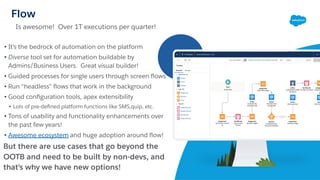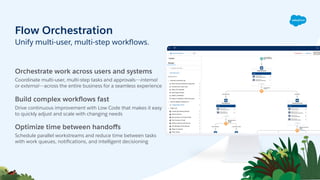Orchestrator and Flow in Slack: Antoine Cabot - Jacksonville Architects - Salesforce
- 1. Flow Orchestration & Flow in Slack Antoine Cabot Senior Director of Product Management June 15, 2022
- 2. Statement under the Private Securities Litigation Reform Act of 1995: This presentation contains forward-looking statements about the companyŌĆÖs ’¼ünancial and operating results, which may include expected GAAP and non-GAAP ’¼ünancial and other operating and non-operating results, including revenue, net income, diluted earnings per share, operating cash ’¼éow growth, operating margin improvement, expected revenue growth, expected current remaining performance obligation growth, expected tax rates, the one-time accounting non-cash charge that was incurred in connection with the Salesforce.org combination; stock-based compensation expenses, amortization of purchased intangibles, shares outstanding, market growth and sustainability goals. The achievement or success of the matters covered by such forward-looking statements involves risks, uncertainties and assumptions. If any such risks or uncertainties materialize or if any of the assumptions prove incorrect, the companys results could di’¼Ćer materially from the results expressed or implied by the forward-looking statements we make. The risks and uncertainties referred to above include -- but are not limited to -- risks associated with the e’¼Ćect of general economic and market conditions; the impact of geopolitical events; the impact of foreign currency exchange rate and interest rate ’¼éuctuations on our results; our business strategy and our plan to build our business, including our strategy to be the leading provider of enterprise cloud computing applications and platforms; the pace of change and innovation in enterprise cloud computing services; the seasonal nature of our sales cycles; the competitive nature of the market in which we participate; our international expansion strategy; the demands on our personnel and infrastructure resulting from signi’¼ücant growth in our customer base and operations, including as a result of acquisitions; our service performance and security, including the resources and costs required to avoid unanticipated downtime and prevent, detect and remediate potential security breaches; the expenses associated with new data centers and third-party infrastructure providers; additional data center capacity; real estate and o’¼āce facilities space; our operating results and cash ’¼éows; new services and product features, including any e’¼Ćorts to expand our services beyond the CRM market; our strategy of acquiring or making investments in complementary businesses, joint ventures, services, technologies and intellectual property rights; the performance and fair value of our investments in complementary businesses through our strategic investment portfolio; our ability to realize the bene’¼üts from strategic partnerships, joint ventures and investments; the impact of future gains or losses from our strategic investment portfolio, including gains or losses from overall market conditions that may a’¼Ćect the publicly traded companies within the company's strategic investment portfolio; our ability to execute our business plans; our ability to successfully integrate acquired businesses and technologies, including delays related to the integration of Tableau due to regulatory review by the United Kingdom Competition and Markets Authority; our ability to continue to grow unearned revenue and remaining performance obligation; our ability to protect our intellectual property rights; our ability to develop our brands; our reliance on third-party hardware, software and platform providers; our dependency on the development and maintenance of the infrastructure of the Internet; the e’¼Ćect of evolving domestic and foreign government regulations, including those related to the provision of services on the Internet, those related to accessing the Internet, and those addressing data privacy, cross-border data transfers and import and export controls; the valuation of our deferred tax assets and the release of related valuation allowances; the potential availability of additional tax assets in the future; the impact of new accounting pronouncements and tax laws; uncertainties a’¼Ćecting our ability to estimate our tax rate; the impact of expensing stock options and other equity awards; the su’¼āciency of our capital resources; factors related to our outstanding debt, revolving credit facility, term loan and loan associated with 50 Fremont; compliance with our debt covenants and lease obligations; current and potential litigation involving us; and the impact of climate change. Further information on these and other factors that could a’¼Ćect the companyŌĆÖs ’¼ünancial results is included in the reports on Forms 10-K, 10-Q and 8-K and in other ’¼ülings it makes with the Securities and Exchange Commission from time to time. These documents are available on the SEC Filings section of the Investor Information section of the companyŌĆÖs website at www.salesforce.com/investor. Salesforce.com, inc. assumes no obligation and does not intend to update these forward-looking statements, except as required by law. Forward-Looking Statement
- 3. Our Agenda 1 2 4 5 3 Flow in Slack Combined scenario Demos Q&A Flow Orchestration
- 4. Orchestration Multi-User Process: Flow Orchestration Skills-based Capacity Work Routing: Omni-Channel Service Level Agreements: Entitlements Interactions Conversational Self-Service: Einstein Bots Component Builder: FlexCards Smart Forms: Flow Builder, OmniScript Integration Low Code API Actions: External Services Data Virtualization: Salesforce Connect Pro-Code Integration: MuleSoft AnyPoint Low-Code Integration: MuleSoft Composer for Salesforce Decisioning Intelligent Actions: Einstein Next Best Action, Einstein Recommendation Builder Intelligent APIs: Einstein Language, Einstein Vision Business Rules: Decision Tables Intelligent Predictions: Einstein Prediction Builder Intelligent Insights: Einstein Discovery Automation Unstructured Data Extraction: Einstein Document Reader Autolaunched, Triggered, Scheduled: Flow Builder Robotic Process Automation: MuleSoft RPA Templates, Actions, Libraries: AppExchange Out-of-the-box Work’¼éows: 900+ Work’¼éow Templates Work’¼éow Libraries & Extended Capabilities Slack AI
- 5. Spectrum of SalesforceŌĆÖs Process Automation Suite The Three Main Ways To Make Things Happen Full Declarative OmniStudio Full Programmatic OmniScript, FlexCards, Data Tools, Rules Engine, Doc Gen Pros: Programmatic level of functionality built with Con’¼üguration For Work’¼éow and UI and Integration, AddŌĆÖl Rules/DocGen/Docusign Functionality Cons: New Skill Set Apex, LWC, AppExchange Pros: Full and virtually unlimited capabilities Cons: Expensive and time consuming to build, deploy, maintain. Work’¼éow Rules, Process Builder, Flow, Orchestrator Pros: Easy To Con’¼ügure, platform integrations(SMS/Quip), ecosystem Cons: Limited UI Design, Limited Integration Capabilities(generally requires Apex/LWC for extensibility)
- 6. Flow ŌĆó ItŌĆÖs the bedrock of automation on the platform ŌĆó Diverse tool set for automation buildable by Admins/Business Users. Great visual builder! ŌĆó Guided processes for single users through screen ’¼éows ŌĆó Run ŌĆ£headlessŌĆØ ’¼éows that work in the background ŌĆó Good con’¼üguration tools, apex extensibility ŌĆó Lots of pre-de’¼üned platform functions like SMS,quip, etc. ŌĆó Tons of usability and functionality enhancements over the past few years! ŌĆó Awesome ecosystem and huge adoption around ’¼éow! But there are use cases that go beyond the OOTB and need to be built by non-devs, and thatŌĆÖs why we have new options! Is awesome! Over 1T executions per quarter!
- 7. When can other tools supplement FlowŌĆ”. Flow OOTB is GREAT for work’¼éow that collects, updates, and/or creates Salesforce data, and interacts with other native functionality (SMS/Quip/Scheduler) Where Flow needs code for extensibility beyond the above: ŌĆó external use cases because LWC is needed to match corporate branding ŌĆó requires invocable apex to utilize external data* ŌĆó requires invocable apex to work with complex queries and hierarchical data ŌĆó doesnŌĆÖt have a native rules engine ŌĆó doesnŌĆÖt support multi-user processes So, if your use case falls into the above, and you donŌĆÖt have dev resourcesŌĆ”ŌĆ” *External servicesŌĆ”.
- 8. Omnistudio introduces new automation tools to reduce the amount of code needed to work with hierarchical/external data and build pixel-perfect UI. It also ADDS a bunch of cool stu’¼Ć that previously reqŌĆÖd LWC Flow Orchestrator letŌĆÖs you run a ŌĆ£’¼éow of ’¼éowsŌĆØ, and aimed at solving for multi-user work’¼éows As a solution architects and admins, you now have a more diverse set of tools in our belt. And donŌĆÖt worry, while weŌĆÖll make comparisons, this isnŌĆÖt an ŌĆ£either/orŌĆØ situationŌĆ”. They can all work together, so it should be ŌĆ£whatŌĆÖs the best tool for the jobŌĆØ Ok, Flow isnŌĆÖt ideal for every use case. Now What? OmniStudio Flow Orchestration
- 9. LetŌĆÖs take a look at Flow Orchestration
- 10. Orchestrate work across users and systems Coordinate multi-user, multi-step tasks and approvalsŌÅżinternal or externalŌÅżacross the entire business for a seamless experience Build complex work’¼éows fast Drive continuous improvement with Low Code that makes it easy to quickly adjust and scale with changing needs Optimize time between hando’¼Ćs Schedule parallel workstreams and reduce time between tasks with work queues, noti’¼ücations, and intelligent decisioning Unify multi-user, multi-step work’¼éows. Flow Orchestration
- 11. 1. Multi-Department Supports complex processes that span multiple teams So When Should you use Flow Orchestration? 3. Low Code Low code tooling empowers devs and admins to scale 2. Parallel Processes Supports parallel processes, not just sequential step by step 4. Supports All Org Incorporates non-Salesforce users who need to participate in work’¼éows Flow Supercharger Flow Orchestration is a unifying layer built on top of Flow, enabling more comprehensive automation
- 13. Deploy your Salesforce automation to Slack Automate communications Create collaboration-based automation with full support for Salesforce data and actions Collect input with guided work’¼éows Update data using guided, multi-step prompts, without needing to log into Salesforce Create an engagement layer for every work’¼éow Add an engagement layer to any work’¼éow including complex process orchestration Flow in Slack
- 14. Send Slack Message Action Get User Get Records Pin Slack Message Action Create Slack Channel Action Invite Users Action Auto-create a channel Create a channel when an opportunity changes and invite all relevant stakeholders to collaborate on next steps Auto-send messages Send messages related to an account status and pin them to ensure new and existing members can ’¼ünd it Get Slack Information Action Archive Slack Channel Action Auto-archive channels Check Slack channel status and auto-archive any open channel when Opportunity stage is Closed Is Channel Archived? Decision Automate Communications Using Slack Actions in Flow Take the guesswork out of collaboration Edit Slack Message Action
- 15. Putting it all Together
- 16. Process Automation Primer Ō¢Ā Processes can be broken down into sub-processes Ō¢Ā Sub-Processes can range from: ŌŚŗ Manual tasks ŌŚŗ Simple record updates ŌŚŗ Complex, integrated, rules based, external facing, etc Business Process Is Not So Simple Or Straightforward
- 17. LetŌĆÖs take a look at a full processŌĆ”.A Loan App/Approval My requirements include: ŌŚÅ I need to capture my customerŌĆÖs application data from our portal with our branding ŌŚÅ I need to have a loan o’¼ācer look at the data collected and make some simple updates ŌŚÅ If the loan is complex/high risk, I need to pull a risk score from an external system and calculate a weighted risk score based on the amount requested, and allow a risk o’¼ācer to make adjustments ŌŚÅ I need to generate loan documents once the credit evaluation is complete So what do I do? I use the right tool for the right job at each stage of the process
- 18. DEMOS
- 19. Q&A
- 20. Thank You




















